Rétság
Rétság (Middle Age name: Réthi Saagh) is a town in Nógrád county, in Northern Hungary. Center of Rétság Municipality. The population is a bit over 2700 people. It was first mentioned at the end of 14th century. For a short time it was a garrison place: the Caserne is a reminder of this. At the end of 16th century, under Otoman occupation, the population was almost wiped out. The southern part of the settlement called Pusztaszántó, there is the classicist mansion from the 19th century.
Get in
.jpg)
By bus
- 🌍 Rétság Bus Round (Rétság autóbusz-forduló), Piac tér, (east 100 m from Hwy 2). Rétság is a local municiality level bus hub. Provide good connections with the neighborn settlement. From Budapest, Újpest-Városkapu (hourly till about 20:30, about an hour), Balassagyarmat (half-hourly till about 22:30, about half hour, 27-31 km). The county bus provider is the Volán. - Season ticket pavilon: Rákóczi út 16.
By car
Rétság is 55 km north of Budapest on the E77 European main road, halfway between Vác and Balassagyarmat.
Get around
- 🌍 Tourinform Rétság Seasonal Branch (Tourinform Rétság Szezonális Iroda), Rákóczi u. 26 (In the Culture Center), ☎ +36 35 550-155, +36 35 550-036, fax: +36 35 550-156, e-mail: retsag@tourinform.hu. Rétság is a small size settlement, but if you get lost, ask the direction here. The office provides information about tourist attractions, accommodations, museums, events on Rétság and its area. Also you can get free regional and national publications, maps.
See
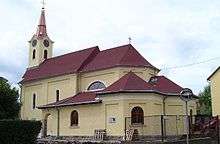
Churches
- 🌍 St. Andrew's Catholic Parish Church (Szent András Katolikus Plébániatemplom), Templom utca 1 (west side of main road), ☎ +36 35 350402. Mid Jun-Aug. This church is a single-nave parish church, built in 1729 in Baroque style with onion helmeted tower. The main altar of St. Andrew shows the Apostle. The sanctuary was expanded in the 19th century. In front of the church, you can find a Second World War monument (II.világháborús emlékmű), a marble tablet, memory of the victims appears during the war died 35 people of Rétság population is listed. The Trinity statue (Szentháromság szobor) in the churchyard is one of the oldest sacral monuments of Rétság. Four meters high.
- 🌍 Chapel ruin (Jászteleki Kápolnarom), Jászteleki út, Old Cemetery (Öregtemető), Siket-Völgy forest (north end of the village).
Museums
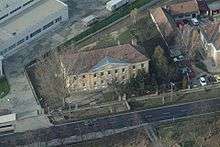
- 🌍 Local History Exhibition (Rétsági Helytörténeti Kiállítás), Templom utca 8 (west of the church), ☎ +36 35 350785. Hemp processing tools of 19-20th centuries, objects of farmers, local history documents of Rétság and the neighboring municipalities, archival photos of the surrounding communities from the 1900s, personal belongings of local celebrities, written materials and publications
Monuments
- 🌍 Liberation monument, a bronze women figure holding an olive-branch in her hands (Felszabadulás emlékmű.), Iskola tér 1, ☎ +36 35 350630, fax: +36 35 350712, e-mail: retsag@vmail.profinter.hu.
- 🌍 Kovács Mansion (Kovács Kúria), Pusztaszántói utca 904 (about 1 km south at OMV petrol station turn to east further ~200 m), ☎ +36 35 350391. The mansion was built in the 19th century in Neo-Classical style. It was renovated and now is in good condition. Above the protruding entrance, there is a balcony with diagonal ironwork. The mansion has a large brick arched cellar.
- Sculptures on Rákoczi street, Rákóczi utca, ☎ +36 35 550100, fax: +36 35 350712. #4 Lidice tragedy memorial (Lidicei tragédia emlékmű) in the printing house yard. A stone pedestal column with a pain expression female figure sculpture and a bronze plate beneath of the statue a statement read history, #8 Victim protection statue (Áldozatvédelmi szobor). A stone bust made by Terman Sándor, the used material was Romhány stonecutter, erected by the White Ring Association, an organization that promotes protection to crime victims #10 Obelisk of 1956 revolution (1956-os emlékoszlop). A nicely carved wooden headboard with an inscription: "1956". It's in nice surroundings.
- 🌍 Monument of 1848-49 revolution and The sculpture of a woman keeping a mask (1848-49-es Emléktábla és a Álarcot tartó nő szobra), Rákóczi utca 26 (between OTP Bank and Tourinform), e-mail: retsag@vmail.profinter.hu. Monument of 1848-49 revolution is a marble tablet on the wall of the community center entrance was erected in commemoration of the Rétság battle fought on July 17, 1849. The sculpture of a woman keeping a mask shows a women statue holding masks in both of her hands on a cylinder-shaped stone pedestal, in Classicist style.
- 🌍 Primate Mindszenty's memorial (Mindszenty emlékmű), Templom utca (former caserne (volt honvédségi laktanya)). Some symbolic prison bars next to concrete wall marble relief panel Mindszenty Prince Primate face. According to the sign on October 30 of the 1956th that spent the first free night in the barracks. Also here is the John Hunyadi plaque (Hunyadi János emléktábla), a marble tablet set in the outer wall of the building of the former barracks commander inscription: "John Hunyadi Belgrade from 1408 to 1456 the brigade was named in memory of a hero of the brigade staff."
- 🌍 Calvary (Kálvária), Zrínyi u. cemetery garden (east of OTP, 10-min walk), ☎ +36 35 550100. Three carved sandstone crucifixes, center cross, colorfully painted corpus. The first part of read-back year: 1863.
- 🌍 Sculptures in the church area, Templom utca and József Attila utca (Close to St. Andrew's Catholic Church). First World War monument (I.világháborús emlékmű): a sand carved stone memorial statue with name of 23 victims who died in World War Rétság carved in a marble table. Tge Millecentenary Memorial Column (Millecentenáriumi Emlékoszlop) is a wooden headboard with tulip and star motifs on a pyramid shaped stone foundation. This was erected for the 1100-year anniversary of the Hungarian Conquest. Inscriptions on the headboard say '896-1996 Rétság' and, on the side, 'If you lived here you would have to die.
Further afield
Thanked to position of its made a good base to exploring the sights of Bánk, Diósjenő, Nógrád, Nőtincs, Tereske settlements.
- 🌍 Bánk (Slovak: Banka) (Nógrád county, East of Rétság). Bánki Lake, a small lake (phone: +36 35 342159), fishing permit Ft 2000/day; typical breeds: carp, pike, bream. Slovak National Village Museum, consisting of a reconstructed parlour, porch and larder, and displaying beautiful examples of old Slovakian weaving and embroidery, Bánk folk costume, and everyday objects and fittings. (Petőfi út 94., Phone:+36 35 300168, Opening hours: Tu-Su 16:00–18:00). Evangelical Late Baroque Church (Hősök tere, Phone:+36 35 550036). Events: Lake festivals. Stay: Tavi Tavi Fészek Fogadó. small guesthouse with six doubles Ft 4400 per person in 2015 including taxes (Loc: Bánk, Petőfi út 53. on the shore of Lake Bánk. Tel.: +36 30 2310494. tavifeszek@wnet.hu) Tengerszem Panzió és Étterem, this pension and restaurant offers ten doubles Ft 9800 per double room in 2015 including taxes (Located 200 meters away from the lake. Petőfi utca 25., Telefon: +3635342159). Tó Wellness Hotel and Restaurant, three-star hotel with 36 double, triple, quad rooms and suites. (Loc: Petőfi út 73. Tel: +36 35 342309, from Ft 19 800 per double room in 2015 including taxes).
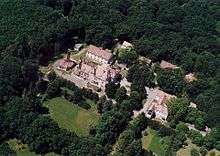
- 🌍 Diósjenő (daily six-seven direct buses, 20 min from Rétság or train from Vác to Diósjenő). Sights: Roman Catholic church and Cemetery: built in the 15th century in Gothic style; rebuilt in 1788-89 in Baroque and Neoclassical style. In the ancient cemetery are tombs from the beginning of 1880s. There is a museum of stonework remains at the western entrance of the cemetery park. There 200-year-old oak and lime trees next to the Classicist church. (Hu:Római Katolikus Mindenszentek Temploma. Loc: end of Kinizsi utca, Phone:+36 35 525012). Protestant church: built around 1850 in late Neoclassical style (Hu: Református Templom. Loc:Dózsa György utca 69. Phone:+36 35 525012 ). Five bridges on the Jenő stream, built between 1914 and 1930 of stone, bricks and ferroconcrete. Sváb Mansion, the ornamented building of a Diósjenő landowner, was built in 1906 in the Romantic and Eclectic styles. There is a characteristic arched gate at the eastern side of its park. It is now a rehabilitation institution. (Hu:Sváb-Kastély. Loc:End Börzsönyi road at foothills, Phone: +36 35 525012, only from outside). In the middle row of cellars. The cellars and wine press houses built at the beginning of 1800s, from adobe bricks or stone and covered by tiles, where wine, vegetables and fruits were stored The majority of these are still used for storage. Mostly out of the over 60 cellars are more or less preserved in their original style and appearance. (Hu:Középső pincesor. Loc: Öreghegy district of Diósjenő, between Catholic church and Protestant church, Phone:+36 35 525012), the upper row of cellars (Hu: Öreghegyi Felső Pincesor. Loc: between Bath and Protestant church). Börzsönyi Nature Conservation Area, the flora of its contents Orchids, Irises, Ferns, and many others. Birdwatchers can find here: Imperial Eagles, Thrushes, Black Storks. Also can see here Lizards, Fire salamanders. Mammals are represented by Red deer, Wild-boar, Roe-Deer, Hare (Hu:Börzsönyi Tájvédelmi Körzet). Gideon Nagy's tomb, He was a dean of the Reformed pastor in the mid-19th century. He and his wife buried here in a black marble tomb, surrounded by wrought-iron fence. His high school friend was Petofi Sandor, a freedom fighter, Hungarian poet. As an Army officer, fought in the 1848-1849 War of Independence.(Hu: Nagy Gedeon síremléke. Loc:Reformed cemetery garden. Phone:+36 35 364351). Diósjenői Lake nature protection area, the 28 hectares Jenői Lake exists since primeval times. The lake is a known touristic site with beautiful landscape. The southern shore is bordered by a pine forest. (Hu:Diósjenői-tó tájvédelmi körzet. Loc: 2 km southeast of Diósjenő). Zsibak-well is very deep. The spring water has iron content. (Hu:Zsibak-forás. Loc: 2 km away from Diósjenő toward Kámori meadow, a couple min detour from 'blue' tourist mark). To Do: Line fishing at Jenői Lake, The watercourse is sandy silt with no rocks. Fishing is permitted only from a pier. Carp, pike, catfish are the most common fishes in the lake.
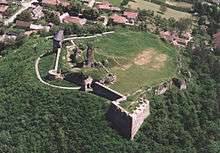
- 🌍 Nógrád (Russian: Новгород, Novgorod-Ugorsky;[German: Neuburg; Slovak: Novohrad) (south of Diósjenő. Between Balassagyarmat and Vác. Take a train from either. Daily 5-6 direct buses, half hour from Rétság.). Dripping-Source, the spring is flowing out from a pipe embedded into a wall of carved stones. (Hu:Csurgó-Forrás, Loc: Petőfi street and railway corner, Phone: +36 35 562000, Location: Petőfi utca-Vasút sarkánál (Nógrád)). Margit-spring a natural monument, the spring has a front wall covered with concrete, with the inscription: Margit-Spring and the year: 1964. Popular among local people as it yields clear and healthy drinking water. The spring originates 150 m from this site, its name is called "Probicska", (Hu:Margit-forrás, Loc:Külterület 1.,Phone: +36 35 562000). Nógrád castle, environment: this is the most famous historical site of Nógrád county. The hill of the castle came into being 15-19 million years ago during the volcanism forming the Börzsöny-mountains. The conic castle hill, erects like a huge loaf from the basin in front of the Börzsöny. The volcanic stone of the hill penetrated the elder layers of sedimented stone, which were later eroded. The more resistant volcanic stone block became increasingly erected from the eroded surroundings The Castle Ruin content element of Ottoman style. The Nógrádian castlehill stands on the southern edge of the village. At an altitude of 286m a.s.l., the relative height of 50-60 m. The steep-sided hills all around well protected, and dominates the area. The far area is keep an eye on from the castle. The castle from the 11th century has been owned by the Bishop of Vac, he was the earliest owner of its. Bishop Nicholas Bathory greatly expanded the castle in the end of 15th century, from 1527 a royal estate. In 1685 a lightning was blew the Gun Powder Magazine. Mostly of walls demolished and the castle was abandoned. The inner castle separated by a deep rock trench from outside part. The outer castles has irregular shape and sized 140x90 meters. A river bridge pillar, a portion of the gate and a decorated with red marble plaque of Nicholas Bathory (1483) dug out from rock ditch in front of the entrance to the inner castle. (Hu:Nógrádi vár, Loc: Hunyadi János út 1. The castle can be reached on the 'blue ruin' sign. Phone: +36 35 562000,hivatal@phnograd.hu). Nógrád Game Park, features all game species that can be hunted in the Börzsöny mountains (Hu: Nógrád Vadaspark, Loc: Szondi u. 67., Phone:+36 35 562002, fax:+36 35 562002.). Folk House, local historical collection, here visible furniture and use objects, his clothes of the local Slovak community from the early 1900s (Hu: Honismereti ház, Loc: Sallai utca 26., Phone: +36 35 362210, fax: +36 35 362001), - St.-István-Memorial Column. The Saint Stephen embossment on a tall wooden column was made by an amateur sculptor. (Hu: Szent István Emlékoszlop , Loc: Hunyadi utca 18.,Phone: +36 35 562000). Memorial of 1848's Freedom fight. A column beautifully put together using huge stones with a "turul" bird on the top and writing at the front that says "1848-1948." (Hu:1848-as emlékmű, Loc: Sallai street -Szondi street corner), - Saint Florian memorial. A colorful statue of St. Florian in a tile covered wooden platform. An old fire engine of the local firemen's association stands next to it. (Hu: Szent Flórián emlékmű, Loc: Szent Flórián tér, Phone: +36 35 362210). Second World War Memorial, a stone statue on a pedestal with a "turul" bird on top and a marble tablet that says "In memory of those who died during the 1941-1944 World War" and lists the names of the 41 Nógrád victims. (Hu:II. világháborús emlékmű, Loc: Újtemető, Rózsa utca -Vasút). Conquest monument, a tall wooden column with a falcon on its top grabbing a deer; the midpart of the column is decorated with portraits of the tribal chiefs who brought the Hungarians to the Carpathian basin. Next to the column is a yurt-like wooden building covered with reed. (Hu:Honfoglalás emlékmű, Loc: Vrsok hill, Phone: +36 35 562000). Parish Church, "Mária Mennybemenetele" Parish Church was built in 1757. Baroque churches bear more simple aspects of a single tower facade, two arches nave was built. Ornamented facade of the main off-basket arch arched windows above the entrance gate is decorated with the bishops inscribed coat of arms. Vases enriched with voluta. The side wall segments are tagged with fancy, head of typical composite wall pillars; closed with brokenlined ledge and on top of its is a typical Baroque tower. Inside the church: The vaults are separated from each other by the semi-circular harnesses. The simple choir loft based on a single arc. The walls are covered mainly ornamental Baroque painting. The walls are mostly covered with ornamental baroque painting, the heavily revised frescoes of the vault of the sanctuary depiction of the most Holy Trinity. Particularly noteworthy is the original, 18th-century furnishings of the church. The main altar with the image of the Assumption of the Virgin Mary, and Louis XVI with kneeling angels and a rococo pulpit and two side altars. On the right side of the altar, the picture you can see a representation of Hungarian saints, on the left, called the Slovaks altar, St. John of Nepomuk, St. Florian, St. Barbara and St. Charles of Borromei shape can be discovered. The village has a church in 1299 as a place featured, here was the Deanery of Nograd, and that title is still held the parish. The earliest parish birth/dye/marrige books originate in 1772 and led to the present day. (Hu: Plébánia Templom, "Mária Mennybemenetele", Loc: Hunyadi út 20.Phone: +36 35 562000). Evangelical Church (Hu:Evangélikus Templom, Loc:Szondi utca, Phone: +36 35 562000, can be visited any time in church service). Calvary chapel, set in picturesque surroundings, beautifully small chapel with colored turret and a cross on top. Built in 1890, renovated in 1993. Inside the chapel a wood carved Pieta visible from Sasvár pilgrimage place, what (says locals) brought a couple Slovak people on his back after they (Hu:Kálvária kápolna, Loc: Újtelep 1.,Phone: +36 35 362042). To Do: enjoy the Long-distance trail the 'Countrywide Blue Trail' pass the village (in Hungarian: Országos Kéktúra, Kéktúra or OKT).
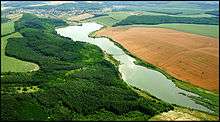
- 🌍 Nőtincs (Slovak: Netejč, German: Nititsch) (limited public bus service from Rétság. 51 km north of Budapest near the European route E77, from Budapest after Szendehely first eastward detour. Nőtincs is seated at the border of Cserhát and Börzsöny hills.). Gurcsány Szcitovoszky Castle park, a nature conservation area, a two hectares garden surrounding the Mansion has been delcared protected in order to preserve the old trees and the English Park character (Hu:Gyurcsányi-Szcitovszky-kúria kertje, Loc: Fő u. 1., Phone: +36 35 360001). Nőtincs Lake, a nature conservation area. An artificial forty hectares lake was dammed up in the picturesque Lókos creek valley. The area became protected in order to preserve the fauna and flora settled here. Line fishing - (Hu: Nőtincsi-tó, Outskirt, Phone: +36 35 560005). Gyurcsányi-Scitovszky Mansion, is a one-story L-shaped Neo Classical mansion. It is a wide and divided entablature and an amusement park was built in the style of mansions of nobility in the middle of the village in 1809. (Hu: Gyurcsányi-Szcitovszky-kúria, Loc: Nőtincs, Szabadság utca 82., Phone: +36 35 360001). Roman Catholic Church, was built in the Gothic style in 1415 on the outskirts of the village, in 1720, rebuilt in Baroque style. The church is staying on a small hill, the main entrance opening from the pop-up tower. The main altarpiece made in 1858, depicts St Martin. St. Martin was known as the guardian of patients and poor people, he was the bishop of Tours, who lived between 316-397, the patron saint of France. A Gothic monstrance compartment and 16th-century mural fragments can be found in cross-vaulted sanctuary. The Rococo style pulpit is the great value of the church. The organ is made in 1942. The bell tower of the church has three bells the biggest (78cm) bell was cast in 1890, the two smaller bells were made in 1923 and 1929. The church contents both Gothic, Baroque, Rococo and Popular architectural styles. (Hu: Római Katolikus Templom, Loc: Szondi u. 2., Phone: +36 35 360001). Seholsziget Theme Park, a zoo, forest park, nature protection area, accommodation and horse riding available here (Hu: Seholsziget Kalandpark, Loc: Diófa utca 41., Phone: +36 20 9341958, daily 10:00-18:00 — info@seszi.hu). St. John of Nepomuk and St. Amalia chapel (Hu:Nepomuki Szent János és Szent Amália kápolnája, Phone: +36 35 360001).
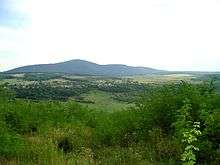
- 🌍 Ősagárd (Slovak: Agárd) (In Nógrád county, a couplekm est of Nőtincs village. Bus connected with Rétság). Sinkár-brook valley, a geological ruptures in the valley of the Sinkár-brook reveal very ancient layers of Triassic rockplates. (Hu: Sinkár ér völgye. Loc: Outskirt, Southeast of the village). Zsömle-cave is a geological rarity of the cave is a hole having a globular shape, which came into being during a dissolution by thermal waters over 200 million years ago. Nine other, smaller caves can be found in the surrounding of the cave ( outskirt, southeast about 3 km, east of the Násznép cave). Village house, local historical and ethnographical collection (Rákóczi utca 38., Phone: +36 35 360368, +36 20 3309711, Open: by booking, Admission: free). Evangelical Church, built in Late Baroque style (Loc.:Rákóczi utca, Phone: +36 35 360368).
Do
The town is at the border of Cserhát and Börzsöny hills giving opportunity to many outdoor activity. Bánk village, a couple of km eastward, is one of the best skiing areas in Hungary.
- 🌍 Grass airfield for microlighters (by the west end of the Village).
Buy
- 🌍 OTP Bank Rétság (OTP Rétsági Fiók), Rákóczi utca 28. (Center), ☎ +36 40 366-388, +36 1 3666-388, fax: +36 35 550-609. M 07:45-17:00; Tu 07:45-15:00; W 07:45-16:00; Th 07:45-15:00; F 07:45-14:00. Traded currencies: USD, EUR. 24-hr ATM.
Eat
- Anna Restaurant (Anna Étterem), Nagyparkoló 4-5 (Between OTP Bank and Tourinform Office), ☎ +36 35 350634, e-mail: annaterem@freemail.hu. 11:00-20:00 (winter only till 19:00 ). Pleasant service, friendly atmosphere. Local homemade favourites.
- Rompos Confectionery (Rompos Cukrászda), Nagypakoló tér 1. (next to Anna Restaurant), ☎ +36 35 350295. Daily 10:00-20:00 (winter only till 19:00). Sweet and salty snacks.
- ZuluCafé Restaurant, Rákóczi út 39-41 (~Opp. Tourinform), ☎ +36 20 3499822. Su-Th 11:00-23:00, F-Sa 11:00-02:00. African style. Live music on weekends. Hungarian, folk and international food. Pizzas. Wine evenings.
Drink
Sleep
There is only one accommodation. More option can be find in Vác or Bánk (see above)
- 🌍 Lókos Pension, Rákóczi út 294 (South of St. Andrew's Catholic Parish Church), ☎ +36 35 550206, +36 20 9547286, e-mail: lokos2001kft@freemail.hu. A small seven rooms place. Horse riding, fishing, football field nearby. Ft 2400 p.p. in double.
Connect
- 🌍 Post Office (Magyar Posta), Rákóczi utca 30. (Next to OTP Bank), ☎ +36 35 350605, fax: +36 35 550058, e-mail: ugyfelszolgalat@posta.hu. M 08:00-12:00, 12:30-18:00; Tu-Th 08:00-12:00, 12:30-16:00th F 08:00-12:00, 12:30-15:00.
Go next
- Balassagyarmat a bordertown on the shore of Iper River
- Vác the cathedral on is the building that defines the town